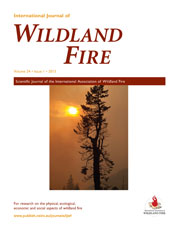International Journal of Wildland Fire
Volume 24
Number 1 2015
There have been suggestions that management-imposed reductions in the frequency and intensity of wildfires in savannas could lead to significant sequestration of carbon into additional tree biomass. However, we contend that in northern Australian eucalypt savannas, tree biomass is already close to its upper bound, and it is likely to be relatively unresponsive to fire management.
Spring–summer vapour pressure deficit (VPD) correlates at least as strongly with annual burned forest area in the southwest United States as does any evaluated climate or moisture variable. Climate models predict VPD to continue increasing due to warming, implying continued increases in southwestern forest fire area when fuels are not limiting.
For the past 100 years, area burned in forests has been more strongly tied to climate than in lower-elevation non-forested ecosystems. In these forests, fire activity is highly dependent on spring precipitation and summer temperatures and less so on winter conditions. Over this time frame, the relationship between fire and climate has not been static and temperature has played an increasingly important role in recent decades.
In southern California, a region dominated by human-caused ignitions, a disproportionate number and extent of fires were associated with specific ignition causes, and this may be due to their distinctive spatial and temporal patterns. Fire prevention programmes could prioritise strategies and optimise resources by focussing on specific causes, locations and timing of ignitions.
A focus on the response of plants to the most recent burn limits our ability to answer questions on the appropriate fire regimes for conservation. We found that the fire regime strongly influenced richness and abundance of species categorised as mid-storey trees and those individuals currently in the mid-level strata.
For shrub–steppe fires, this study validates the Monitoring Trends in Burn Severity (MTBS) burned area perimeter product. Although it provides reasonable assessments of the fire perimeter, it oversimplifies the within-fire area. Studies using MTBS data to analyse area burned trends should constrain the burned area product with spectral indices.
We investigated the applicability of the Fine Fuel Moisture Code, one component of the Canadian Forest Fire Weather Index System, in tracking the changes in masticated surface fuel moisture content. Calibration techniques and modifications to the model improved the accuracy of moisture estimates for a boreal forest mastication treatment in west-central Alberta, Canada.
Canopy base height and canopy bulk density are the canopy fuel characteristics more related to crown fire potential at stand level. The current models used to estimate their value are not sensitive to silvicultural treatments. In this study, innovative dynamic models including the effect of thinning have been developed.
The paper compared the MCD45A1 and official dataset on the forest burned area in mainland China from 2001 to 2011. The two datasets were comparable on the national scale but showed large differences on the subnational scale, especially for south-west China. MCD45A1 correctly identified the forest fire seasons.
Litter moisture content of larch stands in Daxinganling Region, China can be accurately predicted by two quasi-physical models proposed by Australian scientists at 1-h intervals, thus expanding the applicability of the two models.
A model for the energy transfer from a wildfire to a moss-covered peatland surface typical of a boreal forested peatland is presented. The ability of the surface moss layer to ignite was assessed based on model outputs coupled with field observations of surface moisture content during normal and drought periods.
The standard approach to isolating and cataloguing assets for protection is not compatible with how people experience their landscapes. The everyday integration of local historical and ecological knowledge, and of spatial and temporal scales, overcomes public and private boundaries, informing people’s interpretation of fire management and risk.
We analysed rebuilding and new development after wildfires destroyed buildings. While only a quarter of homes were rebuilt within 5 years post-fire, new development rates inside versus outside fire perimeters were similar, suggesting that wildfire risk had a limited effect on decisions to live in a fire-prone area.




